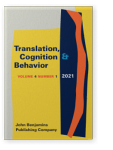Vol. 4:1 (2021) ► pp.98–123
Literal is not always easier
Literal and default translation, cognitive effort, and comparable corpora
“Literal translation” is a popular construct in Translation Studies. Research from computational approaches has consistently shown that non-literal translations, i.e., renderings semantically and syntactically different or not close to the source text, are more difficult or effortful to produce than literal ones. This paper researches whether literal translations are systematically less effortful to process than non-literal ones using comparable corpus data. The effort incurred in processing literal translations from a parallel corpus is compared to that of processing the most frequent non-literal renderings found in previous comparable corpus studies. Ten professional translators edited a text using a mock translation environment setup using the keylogger Inputlog. The task was presented as a regular editing process with a full cohesive text presented segment pair by segment pair. Time served as a proxy for overall cognitive effort. We analyzed time from presentation to type (TTP) and time to completion of segment edit (TC), or complete editing events. Results showed that processing efforts are indistinguishable between categories, suggesting that cognitive effort to edit non-literal default translation candidates is not always higher when compared to the most frequent literal translations from a parallel corpus.
Article outline
- 1.Introduction and rationale
- 2.Literal translation
- 3.Default translation
- 4.Cognitive effort and editing
- 5.Empirical study
- 5.1Methodology
- 5.2Corpus data
- 5.3Data analysis
- 5.4Research questions
- 5.5Statistical analysis
- 6.Results
- 7.Conclusions
- Notes
-
References
